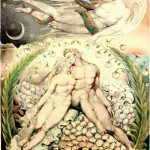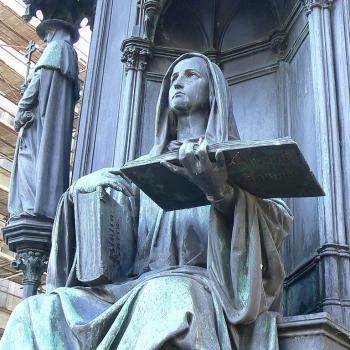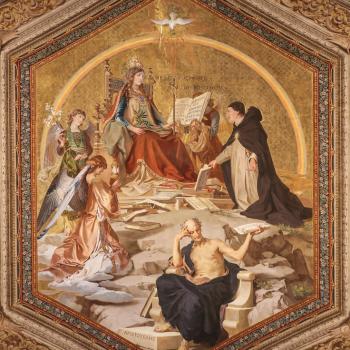![Isaiah worshipping the Virgin Mary and Child Jesus, Early 13th century. Saint Catherine's Monastery, Sinai (Egypt) / K. Weitzmann: "Die Ikone"See page for author [Public domain], via Wikimedia Commons](https://wp-media.patheos.com/blogs/sites/637/2016/06/Isajah__Mary_Icon_Sinai_13th_century-232x300.jpg)
Our exploration of some of the objections raised against the veneration of Mary and the saints, objections which tend to come from a misunderstanding of the Ten Commandments, has set the stage for us to explore and better understand the veneration which is given to Mary and the saints. But before we go further, we must also respond to one other objection: whether or not we are worshiping Mary, and if so, if such worship is to be rejected because it gives to Mary what is to be given to God alone. The key to answering this is to understand that the word worship can mean many different things, and these meanings often get confused with each other when addressing the veneration of Mary. To be sure, the word worship has, of late, been used mostly to represent the adoration given to God alone, but historically it has been used to indicate any kind of honor or respect shown to someone else and so does not have to be seen as adoration. This is why it was traditional for couples marrying each other to promise to worship each other as a part of their vows – it indicated the kind of honor which they would render to each other, not that either one of the couple thought their mate took the place of God. Worship was understood as a genus which had many species, and though some of those species are still used, like when we talk about hero-worship, for the most part, these distinctions have been leveled out and this has left people confused as to what is and is not acceptable in relation to how we honor and respect someone else. We intuitively understand deep devotion and respect for another becomes a form of worship, but if we do not understand the distinct kinds of worship, we then misconstrue what is permissible and good, honoring someone, as being impermissible and bad because we think we are giving too much respect to them. What we must understand is that the act of worship means we are giving someone great honor and respect, but there are two major forms, absolute worship which is due to the absolute (God) alone, and relative worship, which honors what is honorable in the other while recognizing the source of that which is honored transcends the relative recipient of the honor and comes ultimately from an absolute source outside of those who receive such honor (that is, once again, the source of their good comes from God and to honor them is to honor God as well).[1]
And so, when talking about Marian veneration, we should not be upset if people call it worship, but we must make it clear that we are not giving her honor which is due to God alone. We must not be too concerned with the words being used or debated, but rather, what is actually going on, and why it is acceptable. When we honor Mary with our devotions, we are recognizing the great good done in her, through her, and by her, properly respecting the absolute Good which makes her good possible. It is a relative form of veneration, though it can be seen as the highest form of such veneration because she finds herself, her body, crossing over into the flesh of Jesus, joining with him, so that her life, her deeds, are at the edge of relative and absolute good, allowing for her devotion to be called “hyper-dulia,” that is, the highest form of relative veneration possible. It is worship, when worship is properly understood as rendering honor to someone according to the honor due to them; it is relative, not absolute worship, because that honor given to her is of the relative kind, and in no way is to be seen as equivalent to the absolute given to God alone. Worship which is due to God alone, absolute worship, is never to be rendered to Mary: she is not to be seen as God, however, when we realize she is the vehicle for the incarnation, we realize that the absolute worship of God must take into account this relative honoring of Mary. If we do not, we would be rendering God disrespect, for we would disregard the good he had done in and through her. Instead of honoring him, we would be dishonoring him, and in such a dishonor, we would no longer be giving him the absolute adoration he deserves. To reject the difference between absolute and relative forms of veneration ends up giving to the absolute only relative veneration, and so missing the mark in regards the love which we should be giving to him.
Since we know that if we love our neighbor as ourselves, we are not rendering any less love to God but more, our love for Mary does not detract from our love for God but rather fulfills God’s expectations as to how we should love others. We are called to honor our parents, to love them. Mary, the New Eve, is our spiritual mother. Are we going to fulfill the letter of the law and ignore its spirit? Are we going to dishonor our spiritual mother? And if we use images, pictures, of our loved ones, such as our parents, to bring their presence closer to us as we remember them, so, too, do we find images of Christ, Mary and the saints bring them closer to us, making it much easier for us to render to them our devotion. Their presence is with us in their images, for their image is a part of them, and wherever a part of them is at, so is their presence.[2]
As Mary is our spiritual mother, she is helping us as a mother. Many devotions are made in respect as to how she has shown us such aid – titles of those devotions reveal the greatness of her love. Thus, we find her called by names such as: Our Lady of Perpetual Help, Our Lady the Joy of All Who Sorrow, Loving Mother, Mother of Mercy, and Our Lady of the Sign. She is the best of all possible mothers, desirous for us to find salvation, willing to help us as she sees fit. She has not been rendered inactive by her assumption into heaven. While her earthly life came to an end, she now partakes in eternal life. She has entered eternal glory, and has a life which is far greater, far more powerful, than she had while dwelling on earth, for it has raised her next to Christ her son in heaven, making her Queen of Heaven.[3]
[1] See St. John of Damascus, On the Divine Images. trans. David Anderson (Crestwood, NY: St Vladimir’s Seminary Press, 1980; second edition, 1994), 82 – 90 for a thorough examination of the various kinds of worship available. In it he explains and points out the different kinds of between absolute worship which is given to God alone and relative honor or respect which is to be given to the saints.
[2] We will further explore this in our next contemplation, which is on Mary’s ability (and therefore, the saints’ ability) to hear us.
[3] All who are glorified in heaven will find their glory exponentially increased: the good rendered in history will be rewarded with that much more deifying grace in eternity.
Stay in touch! Like A Little Bit of Nothing on Facebook:
A Little Bit of Nothing












